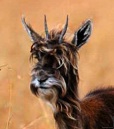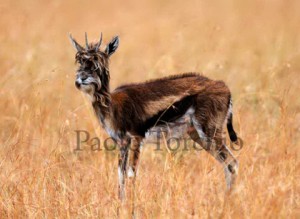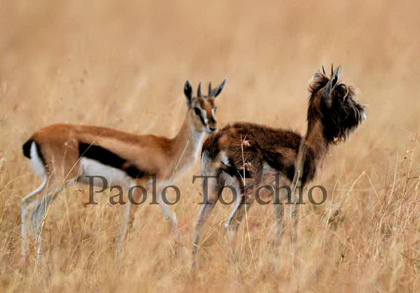Maasai Mara Mystery
Posted by: Loren Coleman on August 23rd, 2010

Photo: Paolo Torchio.
Photographer Paolo Torchio recently came upon a weird-looking antelope on Africa’s Maasai Mara, sometimes written as “Masai Mara.”
The Masai Mara National Reserve is properly spelled Maasai Mara. It is known by the locals as “the Mara,” a large game reserve in southwestern Kenya. The reserve is essencely the northern continuation of the Serengeti National Park game reserve in Tanzania. Named after the Maasai people, the traditional inhabitants of the area, it reflects their description of the area when looked at from a viewpoint – “Mara,” which is Maa (Maasai language) for spotted: an apt description for the circles of trees, scrub, savannah and cloud shadows that mark the area. It is famous for its exceptional population of large felids, game, and the annual migration of zebra, Thomson’s gazelle and wildebeest from the Serengeti every year from July to October, a migration so immense it is called the “Great Migration.”

Photo: Paolo Torchio.
Paula of Baraza’s Wildlife Direct quotes Torchio in noting that capturing an image of something never seen before is every photographer’s dream.
In cryptozoology, being aware of unusual specimens is of assistance in realizing that all reports of cryptids might not be, necessarily, a new species. Nevertheless, it is important to keep track of such incidents, as much as possible. Some examples of these encountered animals may be merely mutated forms of known species, hybrids, or other seemingly strange occurrences among a large normal population.
In the case of this “Masai Mara Mystery,” this animal, with ruffled head, which almost forms a mane, also has longer than normal body fur.

Photo: Paolo Torchio.
From the animals it is with, this is clearly a Thompson’s gazelle (Gazella thomsoni) of some kind. Examples from Masai Mara are easily found on the web (e.g. here and here).

Photo: Paolo Torchio.
For more of Paolo Torchio’s wildlife photographs, click here.
I thank Paolo Torchio for his direct, firsthand permission to post his photographs of this unusual antelope.
About Loren Coleman
Loren Coleman is one of the world’s leading cryptozoologists, some say “the” leading living cryptozoologist. Certainly, he is acknowledged as the current living American researcher and writer who has most popularized cryptozoology in the late 20th and early 21st centuries.
Starting his fieldwork and investigations in 1960, after traveling and trekking extensively in pursuit of cryptozoological mysteries, Coleman began writing to share his experiences in 1969. An honorary member of Ivan T. Sanderson’s Society for the Investigation of the Unexplained in the 1970s, Coleman has been bestowed with similar honorary memberships of the North Idaho College Cryptozoology Club in 1983, and in subsequent years, that of the British Columbia Scientific Cryptozoology Club, CryptoSafari International, and other international organizations. He was also a Life Member and Benefactor of the International Society of Cryptozoology (now-defunct).
Loren Coleman’s daily blog, as a member of the Cryptomundo Team, served as an ongoing avenue of communication for the ever-growing body of cryptozoo news from 2005 through 2013. He returned as an infrequent contributor beginning Halloween week of 2015.
Coleman is the founder in 2003, and current director of the International Cryptozoology Museum in Portland, Maine.










Give it a haircut, and it looks pretty much like the gazelle it’s standing next to.
I’d suggest considering either a disorder causing extreme hair growth, or perhaps a recessive gene that managed to pair up in this instance.
But I’m no expert — just spitballing.
Thanks for the interesting article & photo, Loren.
The mouth looks like someone photo shopped a cat’s mouth (or lion’s) onto a gazelle. It seems too wide to match the normal gazelle. Also, I don’t see how the view of the animal from its right matches the view from its left, in regard to the mane.
I’ve been there. Can’t say I saw THAT. Really weird looking and, if genuine, I must say that it looks like a genetic anomaly. Maybe two distinct, but closely related species mated?
An antelope female made whoopie with a schnauzer-cat hybrid and this popped out 😉
Photoshop.
Lots of causes of hypertrichosis in humans… but it’s most likely to be a charming mutation in this fella (rather than, say, anorexia…).
I hope s/he gets to breed successfully.
The tedious cries of ‘Photoshop’ don’t seem to consider why an experienced and talented wildlife photographer would want to lie about a gazelle being hairy. Scepticism requires a bit more than just habitual doubt.
I would guess genetic mutation, and in this case not beneficial to the individual animal, for various reasons.
As to comments about “Photoshop,” ned-kogar’s point is right to the point, and pointedly right.
Doesn’t look photoshopped at all. The nose and mouth are definitely a gazelle, the reason it looks slightly like a cat is because the way the fur is shaped out from the sides of the mouth, making it look like cat whiskers/fur. Honestly, looks more like a dogs face though. Like a Yorkie, or something like that.
I’m with Krakatoa though, if you buzzed that hair off it’s face would look exactly like a normal gazelle. It’s just a slight mutation/variation. Nothing to get too excited about.
I concur ned,
This isn’t a hoax, just a genetic anomaly…and a beautiful animal!
Please don’t always cry “photoshop!” only because you don’t have seen something never before or because it looks strange. There are of course a lot of photoshop-pictures circulating in the net, and sadly many people even believe that some very obviously faked pictures are real. But on the other hand, there are not only some really strange species, but also sometimes strange mutations or diseases, which can cause a very weird looking animal. In this case, there is also another very good indications that this photos are no hoaxes, because we have photos from several directions, what’s normally not the case in photoshopped pictures, because this would often be by far much more work. If you know how photoshop or similar programs work, mainly by combining different photos, it is clear that you can only combine photos to a chimera if the directions of the animals are similar. You can manipulate this to some degree if they aren’t completely synchronously for a single picture, but in general it is very hard to make photoshopped pictures from different angles, because you also need original photos from different angles.
But to come back to this gazelle, it’s obvious that they single reason why it looks so strange is abnormally long fur. The absence of fur or too long fur can have a dramatic effect on the look of an animal, because it can change the proportions a lot. Animals we know only with thick fur can look extremely bizarre, what’s the reason why many people are thinking furless coyotes are chupacabras and furless racoon carcasses strange monsters.
If you look at domestic mammals you will find breeds with very long hair nearly everywhere, in dogs, cats, sheep, rabbits, goats, pigs, guinea pigs, donkeys and some more. In some cases the hair growth is actually rather enormous. This long hair is caused by simple mutations, and of course such mutations do not only occur in populations kept by humans, but also in the wild.
Thanks to all the good comment refusing that it was a Photoshop creature.
First, I don’t need to spoil my name with a stupid false picture, second, it is easier to find a real hairy gazelle, rather then add all those hairs one by one.
Thanks to everybody.
Paolo – Great find and excellent work. Thank you for sharing that!
Robert Berntsen now forwarded other pictures of this animal which he has taken on 31st October. He reports that “It looked like a young male Thomson but with deformed head and upper neck. In addition there were long black strands of hair all over its body. On its head the blood vessels seem to be abnormally thick. Its size and behaviour looked quit normal and was accompanied by other Thomson’s gazelles, although seemed to stay in the outskirts of the group.”
Source: Wildlife Extra
To me it looks photoshopped. Or it’s just an over hairy gazelle.